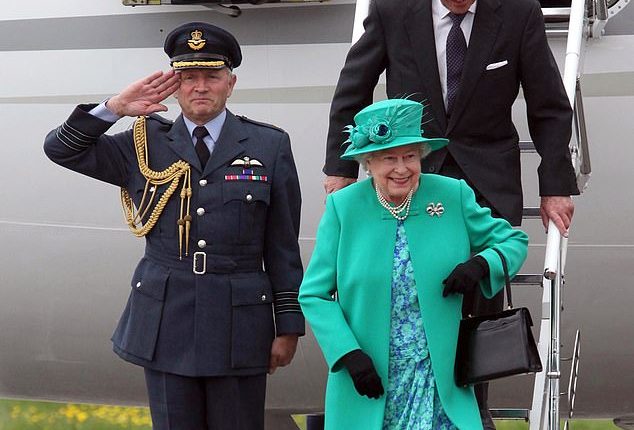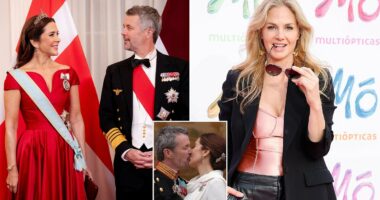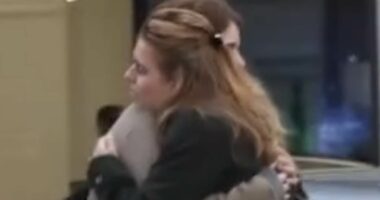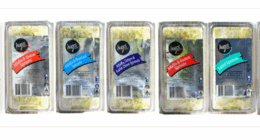Share this @internewscast.com
Throughout her reign, Queen Elizabeth II was more than a monarch – she was a master of sartorial diplomacy.
Ever mindful of the occasion, the Queen selected her outfits to reflect the culture and traditions of the people she was meeting.
She collaborated closely with her Personal Assistant and Senior Dresser, Angela Kelly, to create looks that were respectful and culturally sensitive.
One standout example was Elizabeth’s historic trip to the Republic of Ireland in May 2011 – the first by a British monarch in a century.
King George V visited Ireland in 1911, when it was still part of the United Kingdom. Just five years later, the events that followed paved the way for Irish independence and the formation of the Republic.
No British monarch had ventured there since – until Queen Elizabeth’s landmark trip.
She stepped off the plane alongside Prince Philip, beaming with genuine joy to be there.
To show her respect and affection for Ireland, Elizabeth chose a predominantly jade green outfit, a clear and thoughtful nod to the country’s national colour.

Queen Elizabeth II’s historic trip to the Republic of Ireland in May 2011 was the first by a British monarch in a century

To show her respect and affection for Ireland, Elizabeth chose a predominantly jade green outfit, a clear and thoughtful nod to the country’s national colour

Her hat, created by Rachel Trevor-Morgan, matched the outfit perfectly as Her Majesty met with Irish dignitaries and President Mary McAleese
Her hat, created by Rachel Trevor-Morgan, matched the outfit perfectly as Her Majesty met with Irish dignitaries and President Mary McAleese.
In her book Dressing the Queen, Angela Kelly shares how, for the state banquet at Dublin Castle, Elizabeth gave particular instructions for her evening gown.
‘The Queen was very specific in her guidance: The gown featured more than two thousand silk shamrocks especially designed for the dress and sewn by hand.’
Tina, the expert beadier, carried out the detailed and ‘painstaking’ work, helping bring the design to life.
In place of her usual Royal Family Order, a sparkling crystal harp – the symbol of Ireland – was designed and placed on the Queen’s left shoulder.
Atop her elegant outfit, Queen Elizabeth wore the Girls of Great Britain and Ireland Tiara, offering another sentimental nod to history.
The tiara had originally been a wedding gift to her grandmother, Queen Mary, in 1893, purchased through donations from young women across Great Britain and Ireland.
Elizabeth’s thoughtful combination of style, symbolism and respect was warmly received. However, it was her banquet speech that truly captivated the nation.

In her book Dressing the Queen, Angela Kelly shares how, for the state banquet at Dublin Castle, Elizabeth gave particular instructions for her evening gown

‘The Queen was very specific in her guidance: The gown featured more than two thousand silk shamrocks especially designed for the dress and sewn by hand,’ Angela Kelly writes

Atop her elegant outfit, Queen Elizabeth wore the Girls of Great Britain and Ireland Tiara, offering another sentimental nod to history
Opening in Gaelic, she greeted the room with: ‘A Uachtaráin, agus a chairde’ – ‘President and friends.’ The crowd fell into a stunned silence before erupting in applause.
It later emerged that Elizabeth had chosen to speak Irish against official advice, which warned that a mispronunciation could overshadow the visit.
She continued in English: ‘Madam President, Prince Philip and I are delighted to be here, and to experience at first hand Ireland’s world-famous hospitality’.
But it was one poignant line that resonated deeply: ‘With the benefit of historical hindsight, we can all see things which we would wish had been done differently or not at all.’ A rare and powerful reflection, almost an apology.
Behind the scenes, those involved in arranging the visit – years in the making – admitted to feeling nervous.
It was a politically delicate moment, requiring immense sensitivity – crowds of protestors had gathered outside the castle.
Security in Ireland was at an all-time high, mindful of the Queen’s personal connection to the past.
In 1979, Lord Mountbatten, her second cousin and the late Duke of Edinburgh’s maternal uncle, was murdered by the IRA.

It was a politically delicate moment, requiring immense sensitivity – crowds of protestors had gathered outside the castle

Behind the scenes, those involved in arranging the visit – which was years in the making – admitted to feeling nervous

Elizabeth had just four days to help bridge centuries of division and the wounds of a long and painful history. Her itinerary included visits to deeply symbolic locations for Irish national identity
Elizabeth had just four days to help bridge centuries of division and the wounds of a long and painful history.
Her itinerary included visits to deeply symbolic locations for Irish national identity.
Emotions ran high and, for many, the legacy of Empire and the Troubles was still raw, despite the peace secured by the Good Friday Agreement in 1998.
At Dublin’s Garden of Remembrance – dedicated to ‘all those who gave their lives in the cause of Irish freedom’ – the Queen laid a wreath and bowed her head in a gesture of respect.
Later, she joined the Irish president at Islandbridge war memorial to honour Irish soldiers who died in British uniform during the World Wars.
These men, who had long been overlooked or even condemned in Irish memory, were remembered that day and continue to be in the years since.








